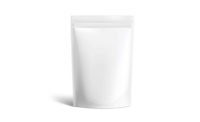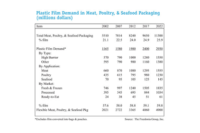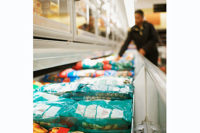The horizontal and vertical form-fill-seal machinery sectors will grow faster than almost any other packaging machinery segment between 2018 and 2024 with compound annual growth rates (CAGRs) just above 4 percent, according to the 2021 World Packaging Machinery Report published by PMMI, the Association for Packaging and Processing Technologies.
Sales of horizontal and vertical form-fill-seal machines typically outperform most other packaging machinery segments due to strong demand from the food industry, the largest market for these machines. This comes as no surprise since this equipment forms, fills and seals flexible packaging such as pouches and bags, which address market demands for sustainability, convenience, security and safety.
Flexible packaging also is well suited to meeting the needs of the growing ecommerce and meal kit markets. According to Midan Marketing, the number of consumers buying meat online continues to increase. In March 2021, Midan surveyed 1,000 meat and chicken consumers and found 33 percent purchased meat or chicken online for the first time since the pandemic began, up from 21 percent in April 2020 when much of the U.S. population was under stay-at-home orders. Consumers who order online like the convenience of eliminating the need to shop in person. Many online buyers also emphasize the importance of family meals and home-cooked food. This bodes well for prepared meat, poultry and seafood products such as meatballs and shredded chicken, which streamline meal preparation. These products often rely on flexible packaging (pouches and bags), which runs on form-fill-seal equipment.
Equipment evolves
Form-fill-seal equipment designed to handle raw, frozen or prepared meat, poultry and seafood products focuses on flexibility and hygienic design. Sanitary design features stainless steel construction, eliminates flat surfaces and crevices, seals electronics to prevent moisture ingress during washdown and makes it easy to reach and clean all components.
Built-in flexibility yields machines that accommodate products that vary in size and shape, produce multiple package formats (skin, vacuum, modified atmosphere), and/or handle different types of film and pouch/bag styles and sizes. Common pouch/bag styles include pillow, flat-bottom and gusseted. Easy-open and reclose features like tear strips and zippers also can be accommodated. For higher volume needs, machines capable of speeds of up to 120 bags per minute are readily available.
Large touch-screen operator interfaces and smart connected platforms simplify controls and offer advanced features such as remote monitoring and augmented reality capability to expedite maintenance and troubleshooting. Other important attributes include easy integration with labeling and coding equipment and quick changeover. The latter can be expedited by quick-disconnect parts such as heating elements and sealing jaws, automated adjustments, automated film splicing and dual reel holders.
One new flow wrapper (horizontal form-fill-seal) model simplifies belt removal and consolidates electrical and mechanical components to cut the number of cabinets to two. To create leak-free trayed products, film is stretched around the product and the package is vacuumed and sealed before moving through a hot-air or hot-water tunnel where just the ends of the package are shrunk so graphics are not distorted.
Sustainable materials
On the materials side, interest in sustainable packaging has not wavered. If anything, it’s growing and suppliers are introducing materials that are easier to recycle, compostable, based on renewable resources and/or contain recycled content.
One heat-resistant compostable film is certified for both industrial and home composting environments. Compatible with ovenable and microwaveable applications, the printable heat-seal coating/cellulose/heat-seal coating film is based on renewable resources and combines heat-sealability with an excellent barrier to gases and aromas, resistance to oils and greases, high transparency and gloss, anti-static properties and controlled slip characteristics.
Another renewable material, polyethylene furanoate (PEF), is derived from plants and outperforms polyethylene terephthalate (PET) films in terms of water vapor barrier (2X to 3X), oxygen barrier (10X) and mechanical strength. The oxygen and aroma barrier makes the material particularly suitable for packaging fish. PEF film is quite new to the market and not yet widely available, but a report from Grand View Research, “Polyethylene Furanoate Films Market…,” predicts demand for the material will experience a 9.7 percent compound annual growth rate that will push annual sales to $801,000 in 2035.
Many films used for meat, poultry and seafood packaging consist of multiple materials and therefore are unlikely to be recycled. Mono-material films overcome that problem. One new all-PET film also scores additional sustainability points because it represents a source reduction of almost 10 percent versus multilayer films, contains post-consumer-recycled content and seals more quickly at lower temperatures thereby saving energy. Superior sealability characteristics ensure strong seals even through contamination. Options include peelable seals. With some mono-material films, brand owners may choose crystal clear or a color.
With ongoing developments in materials and form-fill-seal machines, it’s likely consumers will find even more pouched or bagged meat, poultry and seafood products in retail refrigerator and freezer cases as well as in their online grocery order or meal kit box.




Report Abusive Comment